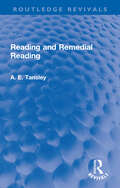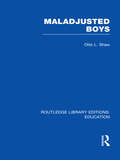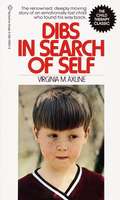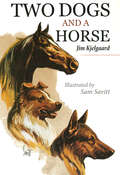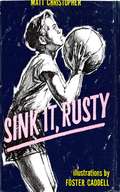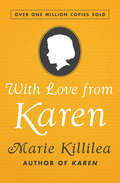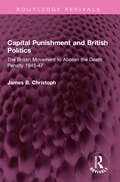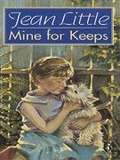- Table View
- List View
The Demography and Causes of Blindness
by Hyman GoldsteinA report on the statistics of blindness from an international point of view.
No Time to Lose: A Symposium
by Pauline M. MoorMultiply impaired blind children present special educational problems and as their number increases, their educational needs are of increasing concern, because many of them arrive at school severely retarded in their development. Several years ago the American Foundation for the Blind called a seminar to discuss teaching procedures then being used, as well as ideas for new techniques. The participants came from the field of special education; most were classroom teachers who had extensive experience with multiply impaired blind children. This report is an outgrowth of that meeting.
Retrolental Fibroplasia and Autistic Symptomatology: An Investigation into Some Relationships Among Neonatal, Environmental, Developmental and Affective Variables in Blind Prematures
by Joan B. ChaseIn this monograph, based on a study of 263 subjects with RLF (Retrolental Fibroplasia-- an eye condition caused by excessive incubator oxygen), the author examines selected variables which may significantly affect subsequent development.
Ability Structure and Loss of Vision
by Jyrki JuurmaaPsychological testing of the ability structures of the blind and sighted was commenced almost simultaneously during the first decades of this century. However, a majority of the studies concerning the blind, and the most crucial among them, sought to develop IQ-type test batteries, intended mainly for appraising their school achievement. By contrast, systematic studies have not been carried out to explore the relationships among different, mutually relatively independent traits and the quantitative contributions of such traits to different test performances. This lack of interest is perhaps due to the narrow range of occupations regarded as suitable for the blind: there has been no acute need for a more differentiated picture.
Learning Disabilities: Educational Principles and Practices
by Doris J. Johnson Helmer R. MyklebustFocuses on practical solutions to educational problems involving spoken language, reading, writing, arithmetic, & nonverbal disorders, making this book a timeless reference for all who desire a thorough understanding of learning.
Reading and Remedial Reading (Routledge Revivals)
by A. E. TansleyFirst published in 1967, Reading and Remedial Reading describes the normal reading programme in the school where the author taught and the diagnosis and treatment of acute difficulties in learning to read. The work deals mainly with so-called educationally maladjusted children, many of whom showed signs of possible damage to the central nervous system, but Mr Tansley believes that the methods and techniques given are applicable to all children, irrespective of levels of intelligence, who are experiencing difficulties to learn. The results achieved are most encouraging and have been tested by numerous expert visitors from this country and abroad. This is a helpful guide to a large number of people- staffs and students in University Education Departments, educational psychologists, remedial teachers, special-school teachers, primary school teachers, and medical officers in the School Health Service.
To Guide and Guard
by Alexandra HasluckRelates the early history of the guide dog movement in Australia, the beginning ideas, the challenges, pitfalls, and successes.
The Electric Eel
by Christopher W. CoatesDid you know that the adult eel is blind? That baby eels have bright blue eyes? That a whopping four-fifths of the eel's body is tail? There are lots more interesting things to know about eels, and you can read about them in this delightful book.
The Gift of Healing: A Personal Story of Spiritual Therapy
by Ambrose A. Worrall Olga N. Worrall"This is an excellent, thrilling, and highly representative record of the life and ministry of a most lovable, amazing, authentic and committed couple. It is a joy to anticipate that through this book many persons will share the inspiration and strength and faith that accompanies acquaintance with Ambrose and Olga Worrall. I doubt if anyone can adequately estimate the faith which this testimony to the healing power in God's world may have upon many lives."-ROBERT M. COX, Executive Director, The Laymen's Movement
Maladjusted Boys (Routledge Library Editions: Education)
by Otto ShawWritten by the founder of a pioneering establishment for disruptive boys who had been excluded from mainstream schools and in some cases turned to crime, this book discusses the methods and reasons for success of Red Hill School. It also discusses the causes of disruptive or obsessive behaviour and emphasizes how the therapeutic work of Red Hill has helped the pupils involved to adjust socially and psychologically so that they go on to find personal fulfilment and satisfaction.
Steve and the Guide Dogs
by Alberta ArmerFrom the Book jacket: Steve's spirits soared when the Guide Dog School promised him he could raise a puppy. Now that his favorite uncle, Jason, had left home, he felt lonely--and besides, all the pets on the family's dairy farm belonged to Grandma Morley. At last Mr. Dempster, the 4-H leader brought him a beautiful German shepherd puppy especially bred to be a Guide Dog someday for a blind person. Steve loved teaching this important job to his puppy. And he didn't mind at all doing extra farm chores or delivering eggs to pay for the dog's expenses, for he longed to have the pride of finally graduating a full-fledged guide dog. But all did not go smoothly, and Steve had to learn some bitter lessons in heartbreak and in perseverance before he was able to face his failure and find the courage to begin again. Every page of this heartwarming story is illuminated by the author's deep insight into the world of a young boy, as well as by her knowledge of guide-dog training and her love of the majestic redwood country she knows so well. J. C. Kocsis has illustrated this inspiring, moving book with handsome line drawings.
Dibs In Search Of Self
by Virginia M. Axline Leonard CarmichaelThe classic of child therapy. Dibs will not talk. He will not play. He has locked himself in a very special prison. And he is alone. This is the true story of how he learned to reach out for the sunshine, for life . . . how he came to the breathless discovery of himself that brought him back to the world of other children.
Gallaudet: Friend of the Deaf
by Etta DegeringOn a May day in 1814, while watching his younger brothers and sisters at play, Thomas noticed a small girl taking no part. She was Alice Cogswell, and deafness shut her out of the circle. The lack of language created a barrier between her and her friends. Thomas invented a game that helped Alice for the first time in her life to understand that things have names. Thomas knew what he could do. He knew he had to bring education for the deaf to America!
The School
by Henry Viscardi Jr.The true story of a man who opened a K-12 school for children with physical disabilities in the early 1960s. Describes the accomplishments of the children, many of whom had seldom been out of their homes. The book also describes the opposition and discrimination the school's founders faced when the local residents decided they didn't want the school to be built in their neighborhood
The Three Christs of Ypsilanti: A Psychological Study
by Milton RokeachIn 1960 psychologist Milton Rokeach staged an unusual experiment to study questions of identity and delusional thinking. He brought together three chronic schizophrenic patients at Ypsilanti State Hospital in Michigan, each of whom believed himself to be Jesus Christ. For over a year the research team and the three patients met daily. This book is an account of what occurred in and outside these meetings as the three Christs struggled to adjust their concept of themselves against the fact that others claimed the same identity. Although some of the researchers' methods seem questionable by today's standards, this is a fascinating look at how beliefs are formed and sustained, and a poignant portrayal of three deeply troubled human beings.
Two Dogs and a Horse
by Jim KjelgaardHere's three of the best short stories from Jim Kjelgaard! Brad was a huge dog and loyal to one man--Jed Fentress. The villagers joked about the 'lion' that walked beside Old Jed; he'd better be careful! When a local man found Old Jed dead on the trail, Brad was a hunted dog! * * * The hill men said nobody could capture that wild horse, and nothing could tame it. Then young crippled Jed Hale did what no other man in the whole valley had done, and the black was Jed's. * * * Johnny raced to the swamp. A gun and Harold had been missing since early morning. Johnny didn't want Harold to do what Johnny might have to do--kill the wounded goose. And what about the goose's companion, a dog?!
A Dog to Trust: The Saga of a Seeing-Eye Dog
by Joseph E. ChipperfieldTells the story of Arno, an Alsatian dog also known as a German Shepherd Dog, who was trained as the eyes of Ralph, a painter who loses his sight, and in a twist of fate, Arno becomes blind and Ralph becomes his eyes.
The Quiet Flame: Mother Marianne of Molokai
by Eva K. BetzMarianne of Molokai, the lady who did not shun lepers, comes alive in this vividly written fiction for young people.
Sink It, Rusty
by Matt ChristopherAfter recovering from Polio, a disease that left his legs weak, Rusty is worried that he won't be able to play basketball. Then Alect comes to town and starts a local basketball team. Will Rusty be able to help Alec's team win their games?
With Love from Karen
by Marie KillileaWhat happened to Karen, a little girl with cerebral palsy, in the years after her original story was published in the award-winning book "Karen."<P><P> This sequel, undoubtedly greeted with joy by all of us who loved "Karen," in one sense surpasses the first work. Karen, delightful and positive though she is, is depicted far more realistically than in the initial book, which tended to make her a bit of a picture book saint. Her struggles, decisions, and (in all honesty) unquestionable confusion with the expectations of her wonderful family are quite vividly portrayed. (As an example of the last - one wonders why Marie does not realise that much of Karen's dilemma over "walking vs wheelchair" undoubtedly stems from Marie's constant insistence on Karen's walking - she fought the idea of Karen's having a wheelchair at all earlier in the book.) The Killilea family clearly had an unusual and blessed balance - tough-minded, persistent, deeply religious, but hospitable and joyous to the point where their home seemed a favourite stopping place for all whom they knew. Yet many new questions remained unanswered. "Karen," though it did not include many extended family members at length, mentioned a large family - in "With Love from Karen," even the most special occasions include many "honorary" family members but no blood relatives.
With Love from Karen
by Marie KillileaThe Killilea family returns in the heartwarming sequel to national bestseller KarenWith Love from Karen picks up five years after the conclusion of Karen, the miraculous and true story of a girl with cerebral palsy who triumphed against all odds. It follows the Killileas through Karen's teen years and into adulthood. Karen and her family continue to face seemingly insurmountable obstacles: They must fight for Karen's right to attend public school, support Karen in her dream to raise and exhibit champion show dogs, and encourage her in her decision to use a wheelchair or walk on her own. Once again, the Killilea family proves that the power of faith, love, and courage in the face of adversity can make miracles happen.
Capital Punishment and British Politics: The British Movement to Abolish the Death Penalty 1945-47 (Routledge Revivals)
by James B. ChristophFirst published in 1962, Capital Punishment and British Politics illuminates the process of political decision-making in Britain by analysing the complex activities that led to the passage of a major piece of social legislation, the Homicide Act of 1957. His case study, based on dozens of interviews, reveals in detail the workings of British politics and assesses the impact of the clash of ideas and interests on governmental policy. After surveying the legal and historical antecedents of the controversy surrounding the Act, the author traces the development from the abortive attempt to abolish the death penalty under the Labour Government through the spectacular murder cases of the early fifties to the compromise legislation successfully launched by a Conservative Government. Throughout the book analysis is coupled with description, and the concluding chapter demonstrates how this single case contained in microcosm many of the basic elements and dilemmas of the British political process. This fascinating study will be of great interest to students of politics and social legislation everywhere.
Mine For Keeps
by Jean LittleAway at school, Sally Copeland has always dreamed of going home, but now that she's there, she feels frightened and unsure of herself. Will her brother and sister accept her? Will she be able to do things for herself? And what will it be like to go to a regular school and be the only one with cerebral palsy?
Your Hour
by M. RaymondFather Raymond, a Trappist monk, tells several stories of people who have always had deep faith in God's love and mercy, or who have come to know God through suffering and meditation. Each story is a beautiful and thought-provoking meditation on life and the afterlife.
Adjustment to Visual Disability in Adolescence
by Emory L. Cowen Rita P. Underberg Ronald T. Verrillo Frank G. BenhamThis volume describes a three-year research program in which the determination of some factors relating to adjustment in visually disabled adolescents was a prime objective.

